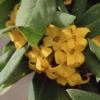 |
DAPHNE jezoensis This Daphne is like no other! For a start it is summer deciduous. This means it looses its leaves in summer, and starts into growth with fresh new foliage at a time when so much else is looking tatty. The flowers are its main attraction though. The deep yellow trumpets are held in groups in typical Daphne fashion in January - March. Deliciously scented, they are truly beautiful. Only a very small handful of this amazing plant remain unsold for Delivery in September. Please check availability prior to ordering |
|
|
|
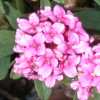 |
DAPHNE juliae Easiest described as similar to D. cneorum, but occurring in Russia, it is proving to be a very satisfactory plant. It seems to be bushier than D. cneorum, with slightly more glaucous foliage. The flowers however, tend to commence a couple of weeks earlier in the season, thus extending your time of colour. |
|
|
|
| DAPHNE
x jintyae 'Pink Cascade' (D. petraea 'Cima Tombea' x D. rodriguezii) The influence of D. rodriguezii in this pretty hybrid is unmistakable, illustrated by the bright glossy, reflexed, evergreen leaves on thin twiggy stems. These are clothed by a mass of sweetly scented, though small, pink flowers in spring. Expect 45cm x 60cm. Robin White questions its cold tolerance due to the rodriguezii influence, but this will be significantly enhanced by well-drained soil of good structure. As such it survived -12 for us last winter. |
|
|
|
|
| DAPHNE kamtschatica I rather like this understated little chap. It is doing really well for me in a heavily shaded woodland area where it merrily produces its small greeny yellow flowers in late winter. Like its showier cousin D. jezoensis, it has the disconcerting habit of dropping its leaves in the summer. 45-60cm. |
|
|
|
|
 |
DAPHNE 'Kilmeston' (D. petraea 'Grandiflora' x D. jasminea) |
|
|
|
| DAPHNE 'Kilmeston
Beauty' (D.caucasica hybrid) Originally thought to be a hybrid with D. bholua, its raiser, Robin White, has now concluded that it is more likely derived from D. tangutica. This gives it enormous potential to be an excellent garden plant. Forming a bushy plant to a little over a metre in all directions, it gives the effect of a more robust, evergreen D. x burkwoodii. Rosy pink in bud and subsequently on the outside of the flower, the interior opens white before maturing to pink. These delightful flowers are sweetly scented. |
|
|
|
|
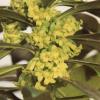 |
DAPHNE laureola This is actually a native, being widespread along woodland margins. It is therefore shade tolerant, and indeed will do better in a shady site. The curious yellow-green flowers are clustered beneath the dark green leaves in February-March. Black berries. |
|
|
|
| DAPHNE
laureola 'Margaret Matthew' This form was selected in Sicily by H. Money-Coutts. It is effectively a geographical variation of D. laureola ssp. philippi (prevalent in the Pyrenees) being compact in it's growth habit as opposed the rather sparse tendencies of our native Spurge Laurel. The bright greenish-yellow flowers are said to be honey scented. |
|
|
|
|
| DAPHNE laureola
subsp. philippi Dwarf, suckering habit with dark glossy green leaves. Dense clusters of greeny-yellow flowers in February. Shade tolerant. Ideal for underplanting trees, but not too close to the trunk as it will not appreciate being too dry in summer; which is of course the case for all Daphnes. |
|
|
|
|
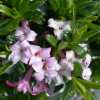 |
DAPHNE
x latymeri 'Spring Sonnet' (D. rodriguezii x D. sericea) Previously listed by its parentage, this recent hybrid is not yet widely known. I have been impressed with how dark green, glossy and yes, healthy, the small leaves have remained. Pink flowers in late spring. Seems happy in full sun provided the soil retains adequate moisture. Expect approx 60cm in all dimensions. Robin White questions its hardiness, but ours have tolerated –15°C outside without damage. |
|
|
|
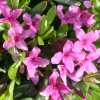 |
DAPHNE 'Leila Haines' x arbuscula This should now be known as Daphne x schlyteri 'Lovisa Maria' |
|
|
|
| DAPHNE
longilobata 'Peter Moore' The long narrow grey-green leaves are margined creamy white creating a very striking effect. Evergreen. White flowers in summer followed by orangey-red berries. Perhaps a touch delicate to plant outside in the harsher areas, but worthy of a winter home in any conservatory. |
|
|
|
|
| DAPHNE x mantensiana
'Audrey Vockins' A recent variegated sport of 'Manten' below; the foliage is conspicuously margined with gold. Ironically this occurred on a plant that originated here! |
|
|
|
|
| DAPHNE x mantensiana
'Manten' (D. x burkwoodii x D. retusa) This pretty hybrid occurred in British Columbia in 1941. It is a dense dwarf shrub to 1m. The fragrant deep rose-pink flowers are borne freely in April-May. Indeed last year, they were still flowering in November! |
|
|
|
|
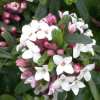 |
DAPHNE
x mauerbachii 'Perfume of Spring' (D. caucasica x D. petraea) There are so many crosses and backcrosses of Daphne today that it is refreshing to find a hybrid that is really different. Rich pink buds open to deliciously fragrant creamy flowers, giving that wonderful contrast between bud and open flower. Delightful tidy habit in a plant making this 60cm x 60cm semi evergreen a real winner. |
|
|
|
| NEW | DAPHNE mezereum |
|
|
|
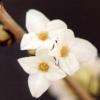 |
DAPHNE mezereum
f. album Upright small shrub with large white flowers all along bare branches in February-March. It thrives on chalk but grows well enough in most normal soils. |
|
|
|
| DAPHNE mezereum
'Bowles White' A selected form of the above. |
|
|
|
|
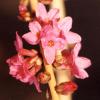 |
DAPHNE mezereum
'Rubrum' This selected form has deep pink-purple flowers and red berries. |